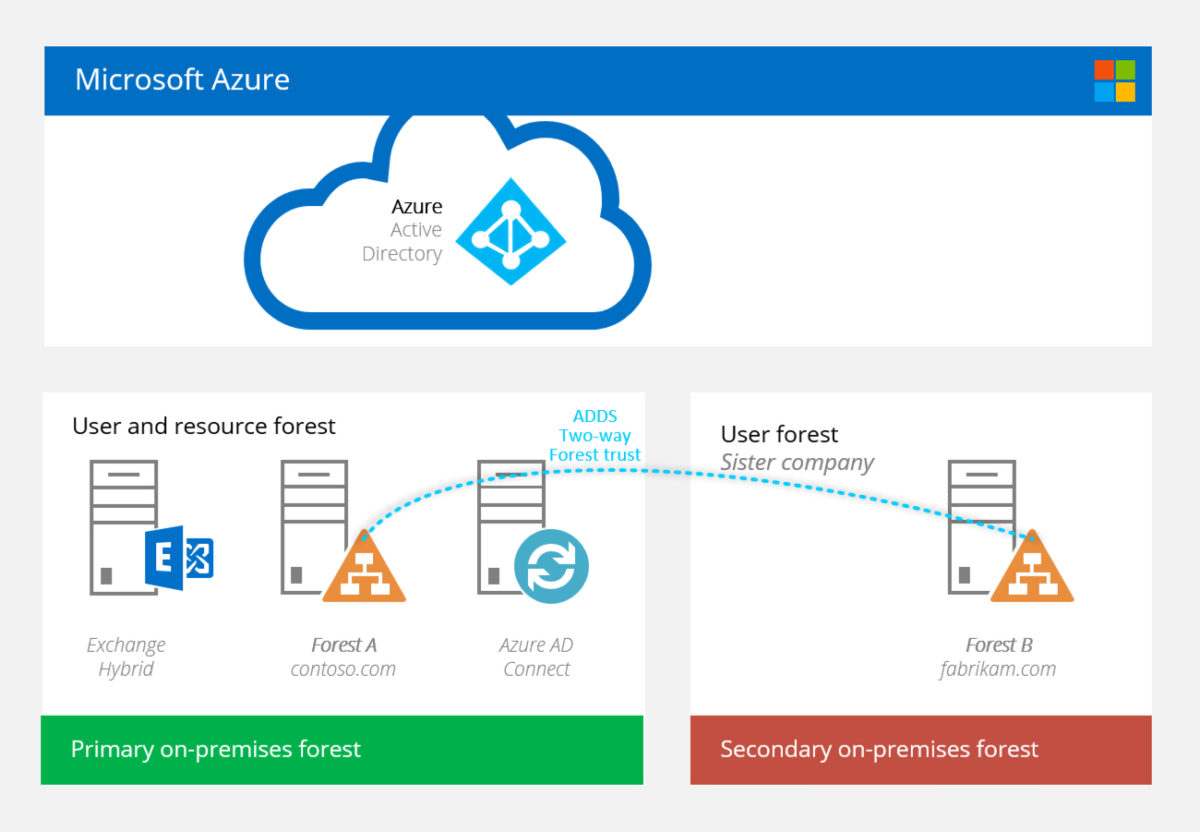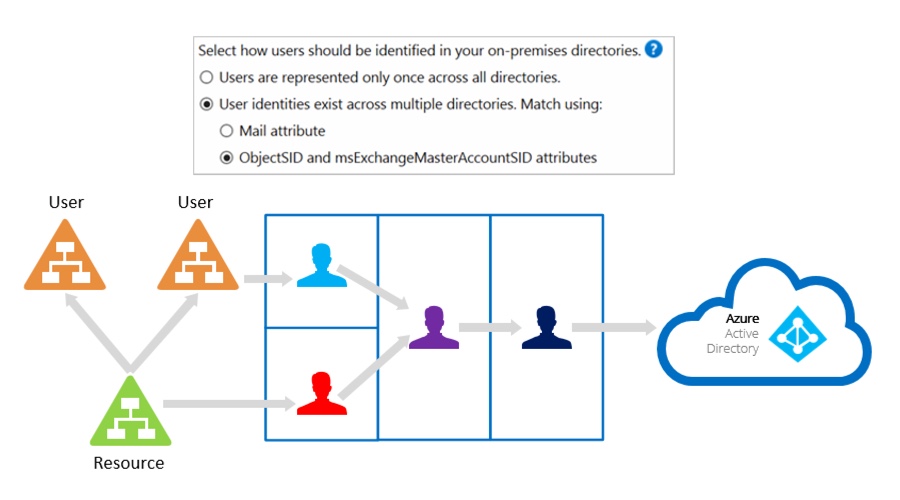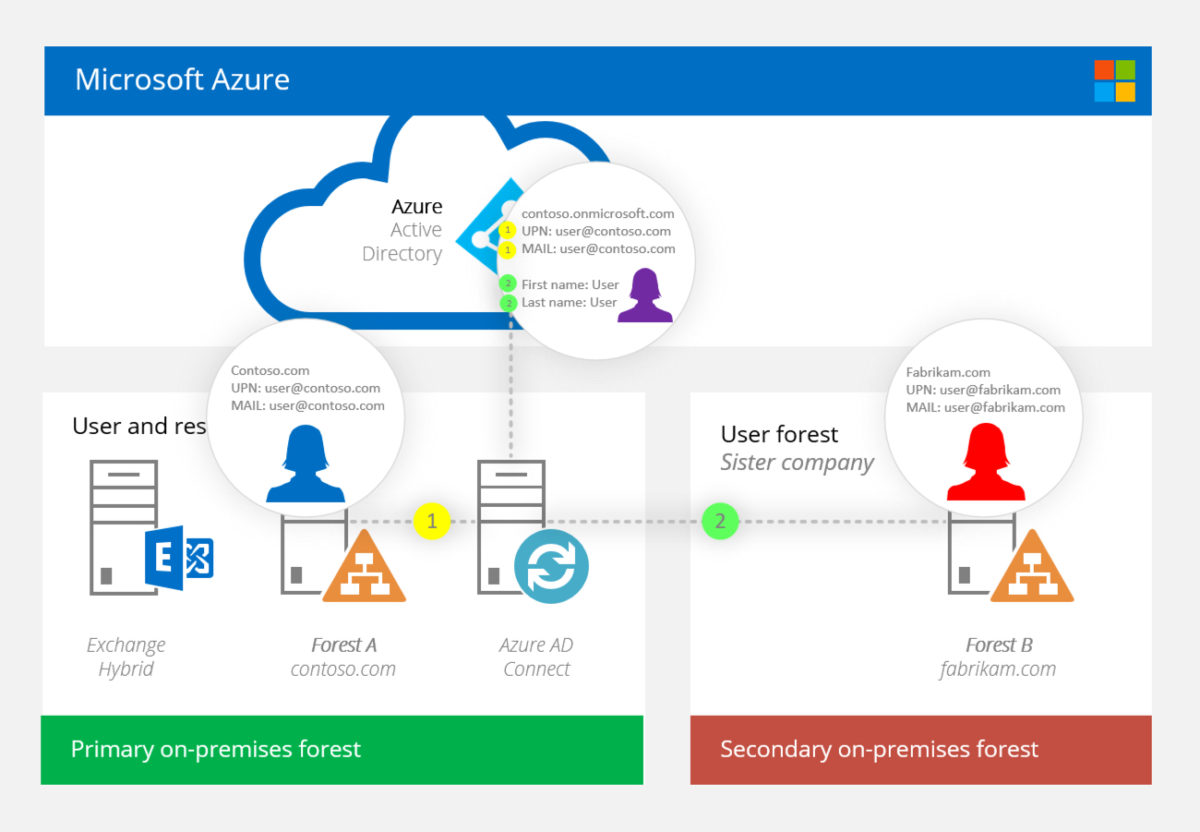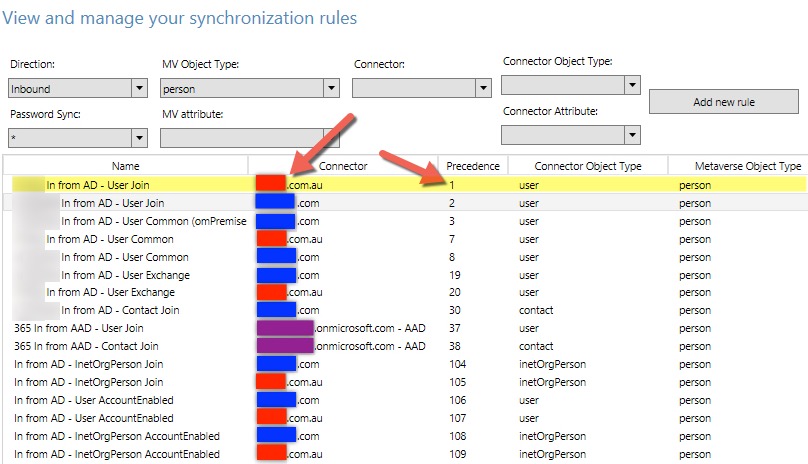Real world Azure AD Connect: multi forest user and resource + user forest implementation
Disclaimer: During October I spent a few weeks working on this blog posts solution at a customer and had to do the responsible thing and pull the pin on further time as I had hit a glass ceiling. I reached what I thought was possible with Azure AD Connect. In comes Nigel Jones (Identity Consultant @ Kloud) who, through a bit of persuasion from Darren (@darrenjrobinson), took it upon himself to smash through that glass ceiling of Azure AD Connect and figured this solution out. Full credit and a big high five!
tl;dr
- Azure AD Connect multi-forest design
- Using AADC to sync user/account + resource shared forest with another user/account only forest
- Why it won’t work out of the box
- How to get around the issue and leverage precedence to make it work
- Visio’s on how it all works for easy digestion
In true Memento style, after the quick disclaimer above, let me take you back for a quick background of the solution and then (possibly) blow your mind with what we have ended up with.
Back to the future
A while back in the world of directory synchronisation with Azure AD, to have a user and resource forest solution synchronised required the use of Microsoft Forefront Identity Manager (FIM), now Microsoft Identity Manager (MIM). From memory, you needed the former of those products (FIM) whenever you had a multi-forest synchronisation environment with Azure AD.
Just like Marty McFly, Azure AD synchronisation went from relative obscurity to the mainstream. In doing so, there have been many advancements and improvements that negate the need to ever deploy FIM or MIM for ever the more complex environment.
When Azure AD Connect, then Azure AD Sync, introduced the ability to synchronise multiple forests in a user + resource model, it opened the door for a lot of organisations to streamline the federated identity design for Azure and Office 365.

In the beginning…
The following outlines a common real world scenario for numerous enterprise organisations. In this environment we have an existing Active Directory forest which includes an Exchange organisation, SharePoint, Skype for Business and many more common services and infrastructure. The business grows and with the wealth and equity purchases another business to diversity or expand. With that comes integration and the sharing of resources.
We have two companies: Contoso and Fabrikam. A two-way trust is set up between the ADDS forests and users can start to collaboration and share resources.
In order to use Exchange, which is the most common example, we need to start to treat Contoso as a resource forest for Fabrikam.
Over at the Contoso forest, IT creates disabled user objects and linked mailboxes Fabrikam users. When where in on-premises world, this works fine. I won’t go into too much more detail, but, I’m sure that you, mr or mrs reader, understand the particulars.
In summary, Contoso is a user and resource forest for itself, and a resource forest for Fabrikam. Fabrikam is simply a user forest with no deployment of Exchange, SharePoint etc.
How does a resource forest topology work with Azure AD Connect?
For the better part of two years now, since AADConnect was AADSync, Microsoft added in support for multi-forest connectivity. Last year, Jason Atherton (awesome Office 365 consultant @ Kloud) wrote a great blog post summarising this compatibility and usage.
In AADConnect, a user/account and resource forest topology is supported. The supported topology assumes that a customer has that simple, no-nonsense architecture. There’s no room for any shared funny business…
AADConnect is able to select the two forests common identities and merge them before synchronising to Azure AD. This process uses the attributes associated with the user objects: objectSID in the user/account forest and the msExchMasterAccountSID in the resource forest, to join the user account and the resource account.
There is also the option for customers to have multiple user forests and a single resource forest. I’ve personally not tried this with more than two forests, so I’m not confident enough to say how additional user/account forests would work out as well. However, please try it out and be sure to let me know via comments below, via Twitter or email me your results!
Quick note: you can also merge two objects by sAmAccountName and sAmAccountName attribute match, or specifying any ADDS attribute to match between the forests.
Compatibility

If you’d like to read up on this a little more, here are two articles reference in detail the above mentioned topologies:
- Active Directory resource forest topology reference: technet.microsoft.com
- Azure AD Connect supported topologies reference: docs.microsoft.com article
Why won’t this work in the example shown?
Generally speaking, the first forest to sync in AADConnect, in a multi-forest implementation, is the user/account forest, which likely is the primary/main forest in an organisation. Lets assume this is the Contoso forest. This will be the first connector to sync in AADConnect. This will have the lowest precedence as well, as with AADConnect, the lower the precedence designated number, the higher the priority.
When the additional user/account forest(s) is added, or the resource forest, these connectors run after the initial Contoso connector due to the default precedence set. From an external perspective, this doesn’t seem like much of a bit deal. AADConnect merges two matching or mirrored user objects by way of the (commonly used) objectSID and msExchMasterAccountSID and away we go. In theory, precedence shouldn’t really matter.
Give me more detail
The issue is that precedence does in deed matter when we go back to our Contoso and Fabrikam example. The reason that this does not work is indeed precedence. Here’s what happens:

- #1 - Contoso is sync’ed to AADC first as it was the first forest connected to AADC
- Adding in Fabrikam first over Contoso doesn’t work either
- #2 - The Fabrikam forest is joined with a second forest connector
- AADC is configured with user identities exist across multiple directories
- objectSID and msExchMasterAccountSID is selected to merge identities
- When the objects are merged, sAmAccountName is taken Contoso forest - #1
- This happens for Contoso forest users AND Fabrikam forest users
- When the objects are merged, mail or primarySMTPaddress is taken Contoso forest - #1
- This happens for Contoso forest users AND Farikam forest users
- Should the two objects not have a completely identical set of attributes, the attributes that are set are pulled
- In this case, most of the user object details come from Fabrikam - #2
- Attributes like the users firstname, lastname, employee ID, branch / office
The result is this standard setup is having Fabrikam users with their resource accounts in Contoso sync’ed, but, have their UPN set with the prefix from the Contoso forest. An example would be a UPN of [email protected] rather than the desired [email protected]. When this happens, there is no SSO as Windows Integrated Authentication in the Fabrikam forest does not recognise the Contoso forest UNP prefix of @contoso.com.
Yes, even with ADDS forest trusts configured correctly and UPN routing etc all working correctly, authentication just does not work. AADC uses the incorrect attributes and sync’s those to Azure AD.
Is there any other way around this?
I’ve touched on and referenced precedence a number of times in this blog post so far. The solution is indeed precedence. The issue that I had experienced was a lack of understanding of precedence in AADConnect. Sure it works on a connector rule level precedence which is set by AADConnect during the configuration process as forests are connected to.
Playing around with precedence was not something I want to do as I didn’t have enough Microsoft Identity Manager or Forefront Identity Manager background to really be certain of the outcome of the joining/merging process of user and resource account objects. I know that FIM/MIM has the option of attribute level precedence, which is what we really wanted here, so my thinking as that we needed FIM/MIM to do the job. Wrong!
In comes Nigel…
Nigel dissected the requirements over the course of a week. He reviewed the configuration in an existing FIM 2010 R2 deployment and found the requirements needed of AADConnect. Having got AADConnect setup, all that was required was tweaking a couple of the inbound rules and moving higher up the precedence order.
Below is the AADConnect Sync Rules editor output from the final configuration of AADConnect:

The solution centres around the main precedence rule, rule #1 for Fabrikam (red arrows pointing and yellow highlight) to be above the highest (and default) Contoso rule (originally #1). When this happened, AADConnect was able to pull the correct sAmAccountName and mail attributes from Fabrikam and keep all the other attributes associated with Exchange mailboxes from Contoso. Happy days!
Final words
Tinkering around with AADConnect shows just how powerful the “cut down FIM/MIM” application is. While AADConnect lacks the in-depth configuration and customisation that you find in FIM/MIM, it packs a lot in a small package! #Impressed